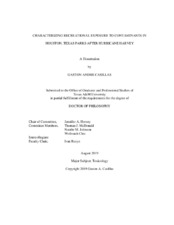| dc.description.abstract | In Houston, flooding is controlled in part by a system of creeks and bayous that include a network of recreation areas, such as parks, trails, playgrounds, and picnic areas. The effects of flooding can have devastating impacts on communities, changing both the physical landscape, and in heavily industrialized communities such as the Greater Houston Area (GHA), altering the chemical profiles of parks and recreation areas. This change in chemical profile can potentially lead to adverse health outcomes in residents using parks. Shortly after Hurricane Harvey, the Texas A&M Superfund Research Center partnered with a local health department to understand the distribution of different chemicals in four park areas near Buffalo Bayou in the GHA in a post flooding environment. Soil samples were collected from the four parks one week after Hurricane Harvey made landfall, and seven weeks later to better understand the distribution of these chemicals over time as the city returned to its typical levels of activity. All environmental sediment samples were analyzed for the U.S. Environmental Protection Agency’s (USEPA) 16 priority polycyclic aromatic hydrocarbons (PAHs), polychlorinated biphenyls (PCBs), legacy organochlorine pesticides, and heavy metals. PAHs were analyzed in the sediment samples at the four park locations. Diagnostic ratios were created using the concentrations of specific priority PAHs in order to broadly predict the potential sources for PAHs in the parks. Potential sources for PAH concentrations in the parks are pyrogenic and vehicular combustion sources. Toxic equivalence factors (TEF) were assigned to give toxicity values to the 16 priority PAHs that did not have specific toxicity values. Only one park area, Addicks Reservoir, showed levels amounting to slight contamination.
Heavy metals were analyzed in the sediment samples to better understand the potential ingestion and dermal exposures in the park areas. The metals concentration in the soil was compared to the Texas Commission for Environmental Quality (TCEQ) average background metal concentrations in soils across the State of Texas. Specific sampling points in the park areas presented with some heavy metals over the average background concentration in Texas, but none of the concentrations were above the USEPA’s ingestion screening levels. PCB’s and legacy organochlorine pesticide concentrations were analyzed in the sediment samples from the four park locations. Mason Park was shown to have elevated PCB and legacy organochlorine pesticide concentrations relative to the other park areas. Hazard indices were developed for understanding exposures to the communities of PCBs and legacy organochlorine pesticides. | en |


